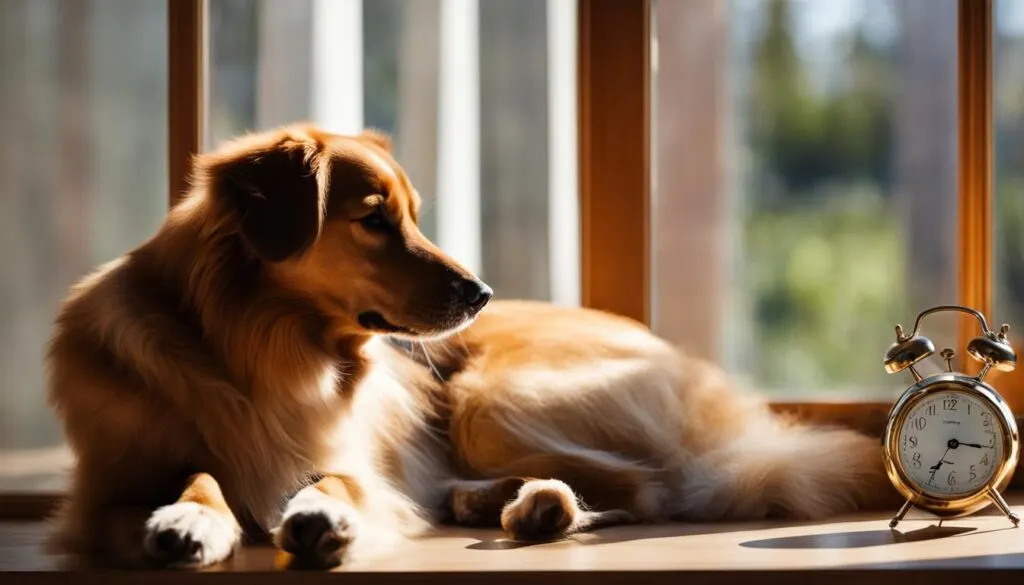Did you know that dogs spend an average of 12 to 14 hours sleeping each day?
That’s right! While it may seem like your furry friend is always full of energy, dogs actually require a significant amount of sleep to maintain their overall health and well-being.
Understanding your dog’s sleep habits and needs is crucial in providing them with the proper rest they require.
Click Here to Jump to a Section
Key Takeaways:
- On average, dogs sleep around 12 to 14 hours a day.
- Understanding your dog’s sleep habits is essential for their overall health.
- Proper rest is crucial in maintaining your dog’s overall well-being.
- Providing a comfortable sleeping environment is important for your dog’s sleep quality.
- Establishing a consistent sleep routine can help regulate your dog’s sleep patterns.
How Do Dogs Sleep?
Dogs have unique sleep patterns that differ from those of humans.
Understanding how dogs sleep and the factors that can affect their slumber is essential for providing them with the rest they need.
In this section, we will dive into the various positions in which dogs sleep and explore the influences on their ability to fall asleep and stay asleep.
Different Sleeping Positions
Dogs may adopt different sleeping positions based on their comfort and relaxation. Here are some common positions dogs sleep in:
- Curled up: Dogs often sleep in a curled-up position, with their tail wrapped around their body. This position helps conserve body heat and provides a sense of security.
- On their side: Sleeping on their side indicates that a dog is comfortable and relaxed. It allows their muscles to fully relax, promoting deep sleep.
- Sprawled out: Some dogs enjoy stretching their legs and sleeping in a sprawled-out position. This position indicates a high level of comfort and confidence.
It’s important to note that dogs may switch between different positions throughout the night to find the most comfortable sleeping arrangement.
Factors Affecting a Dog’s Sleep
Several factors can impact a dog’s ability to fall asleep and stay asleep. These include:
- Physical discomfort: Pain or discomfort from conditions like arthritis or injuries can make it difficult for dogs to find a comfortable sleeping position.
- Anxiety or stress: Dogs that are anxious or stressed may have trouble relaxing and may exhibit restless sleep patterns.
- Noise and disturbance: Loud noises or disruptions in the environment can disrupt a dog’s sleep and cause them to wake up frequently.
- Temperature: Dogs are sensitive to temperature changes, and extreme heat or cold can make it challenging for them to sleep comfortably.
Understanding these factors can help you create a sleep-friendly environment for your furry companion.
By observing your dog’s sleeping positions and addressing any underlying discomfort or stressors, you can ensure that they have a peaceful and restorative sleep.
In the next section, we will explore whether dogs can dream when they sleep.
Can Dogs Dream When They Sleep?
Just like humans, dogs are capable of dreaming when they sleep.
Dogs experience REM (Rapid Eye Movement) sleep, which is the sleep stage associated with dreaming.
During this stage, their brain activity increases, and their eyes may move rapidly behind their closed eyelids.
Dreaming is a natural and essential process for dogs, as it helps their brain process and consolidate information, similar to how it does for humans.
It is a way for them to relive experiences, strengthen memories, and potentially learn from their waking experiences.
So how can you tell if your dog is dreaming?
It’s important to observe their behavior during sleep.
You may notice them twitching, paddling their paws, or making soft noises like barks or whines. These movements and sounds are indicative of their dream activity.
While dogs can certainly dream, the content of their dreams remains a mystery.
We can only speculate about what they dream about, but it’s likely that their dreams revolve around their daily activities, encounters with other animals, or even chasing their favorite toys.
It’s important to note that dogs need uninterrupted sleep to fully benefit from the restorative effects of dreaming.
As pet owners, we should provide them with a peaceful sleep environment and avoid disturbing them during their sleep cycles.

Reasons Why Dogs Sleep a Lot
While it may seem like dogs sleep a lot more than humans, there are actually valid reasons for their increased need for slumber.
Several factors contribute to their extended sleep duration, including age, breed, activity level, and overall health.
The Role of Age
Age is a significant factor in a dog’s sleep requirements. Puppies and older dogs tend to sleep more than adult dogs.
Puppies need ample sleep for growth and development, while senior dogs may require additional rest to compensate for decreased energy levels.
Breed-Specific Needs
Different breeds have varying sleep patterns and requirements.
Larger breeds often need more sleep to restore their energy levels, while smaller breeds may have shorter bursts of sleep throughout the day.
Understanding your dog’s breed-specific needs can help you ensure they get the appropriate amount of rest.
Activity Level
A dog’s activity level directly affects their sleep duration.
More active dogs, such as working or sporting breeds, may require more sleep to recover from their energetic endeavors.
On the other hand, dogs with a lower activity level, such as lap dogs or senior dogs, may be more prone to extended bouts of sleep.
Overall Health
Just like humans, a dog’s overall health can impact their sleep patterns.
Dogs with certain health conditions or recovering from illness or surgery may sleep more as their bodies heal.
If you notice a sudden increase in your dog’s sleep or any other concerning changes, it’s essential to consult with your veterinarian to rule out any underlying health issues.

Dog Sleep Duration by Breed Size
| Breed Size | Average Sleep Duration |
|---|---|
| Small Breeds | 12-16 hours per day |
| Medium Breeds | 10-14 hours per day |
| Large Breeds | 14-18 hours per day |
The table above provides a general guideline for the average sleep duration based on breed size.
It’s important to note that individual dogs may have different sleep needs and variations within each breed.
Consulting with your veterinarian can help you determine the appropriate sleep duration for your specific dog.
The Stages of Dog Sleep
Similar to humans, dogs go through different stages of sleep to achieve rest and rejuvenation.
Understanding these stages can help you ensure that your furry friend is getting the quality sleep they need.
Let’s explore the stages of dog sleep and their significance in their overall sleep cycle.
- REM Sleep: REM stands for Rapid Eye Movement, and it is the stage of sleep where dogs are most likely to dream.
During this stage, their brain activity increases, and their eyes may move rapidly beneath their eyelids.
It is believed that REM sleep plays a crucial role in memory consolidation and emotional processing for dogs, just as it does for humans.
- Non-REM Sleep: Non-REM sleep is the stage where dogs experience deep sleep and physical restoration.
It can be further divided into three sub-stages: N1, N2, and N3. In N1, dogs begin to relax and transition from wakefulness to sleep.In N2, their body temperature drops, heart rate slows down, and they become less responsive to external stimuli.
Finally, in N3, also known as slow-wave sleep, dogs experience the deepest level of sleep, which is essential for their overall well-being.
Importance of Each Stage
Each stage of dog sleep serves a vital purpose in their physical and mental health:
| Stage | Importance |
|---|---|
| REM Sleep | Helps process information, strengthen memory, and regulate emotions. |
| Non-REM Sleep (N2) | Allows the body to conserve energy, repair tissues, and recover from physical exertion. |
| Non-REM Sleep (N3) | Supports growth and development, boosts the immune system, and enhances overall physical health. |
By understanding the different stages of dog sleep and their importance, you can ensure that your canine companion enjoys the benefits of a well-rested and happy life.
Understanding Dog Sleep Patterns
When it comes to understanding dog sleep patterns, it’s important to recognize that dogs have their own unique preferences and behaviors when it comes to rest.
Just like humans, dogs have specific sleep patterns that can vary depending on various factors such as breed, age, and overall health.
Dogs are known for their ability to nap during the day and be more active at certain times.
This is because dogs are crepuscular animals, meaning they are naturally more active during dawn and dusk.
It’s common for dogs to take short naps throughout the day, allowing them to conserve their energy for when they are most active.
To help your dog establish a consistent sleep routine, it’s crucial to provide them with a comfortable and quiet sleeping area.
This can be a designated dog bed or a cozy corner in your home where they feel safe and secure. Creating a peaceful environment will encourage better quality sleep for your furry friend.
A consistent sleep routine can also be beneficial for both you and your dog.
By establishing regular wake and sleep times, you can ensure that your dog gets the rest they need, which in turn can help prevent behavior problems that may arise from lack of sleep.

Benefits of Establishing a Sleep Routine for Your Dog
Establishing a sleep routine for your dog has several benefits:
- Helps regulate their internal body clock
- Promotes better overall health and well-being
- Reduces the risk of obesity and other health issues
- Minimizes anxiety and stress
- Improves behavior and trainability
Creating a Sleep-Friendly Environment
When creating a sleep-friendly environment for your dog, consider the following:
- Choose a comfortable and supportive bed
- Provide a quiet and peaceful space
- Ensure the room is at a comfortable temperature
- Use calming scents or soothing music if necessary
By understanding the sleep patterns of dogs and providing them with the necessary conditions for rest, you can help ensure that your furry companion enjoys a good night’s sleep while also promoting their overall health and well-being.
| Sleep pattern | Duration | Description |
|---|---|---|
| REM Sleep | Around 10-12% of total sleep time | Associated with dreaming, rapid eye movement, and muscle paralysis |
| Non-REM Sleep | The remaining percentage of sleep time | Consists of slow-wave sleep and deep sleep stages |
Canine Sleep Behavior and Health
A dog’s sleep behavior is closely linked to their overall health.
By observing their sleeping positions, we can gain valuable insights into their comfort and well-being.
It’s important to provide a comfortable sleeping environment for your dog to support their physical and mental health.
Dog Sleeping Positions and Their Meanings
Dogs have various sleeping positions, each carrying its own significance. Understanding these positions can give us clues about their state of mind and overall health:
- Curled Up: When dogs sleep in a tight, curled-up position, it indicates a desire for warmth and security. This position helps them conserve body heat, reminiscent of their days as puppies.
- On Their Side: Sleeping on their side with their legs extended suggests that dogs are feeling safe, relaxed, and comfortable in their environment.
- Sprawled Out: Dogs who sleep with their legs stretched out and their belly exposed are expressing a sense of complete vulnerability, signaling that they feel completely at ease and trust their surroundings.
- Back Against a Surface: Some dogs prefer to sleep with their back pressed against a wall or furniture. This position offers them additional support and a sense of security.
By observing your dog’s preferred sleeping position, you can better understand their emotional well-being and make adjustments to their sleeping area to ensure their comfort.
The Importance of Providing a Comfortable Sleeping Environment
A dog’s sleep environment plays a crucial role in their overall health and well-being. Here are some factors to consider when creating a comfortable sleeping area:
- Bedding: Choose a supportive, orthopedic bed that suits your dog’s size and breed. Memory foam or cushioned beds can help relieve pressure on their joints and provide a restful sleep.
- Temperature: Ensure the sleeping area is at an appropriate temperature. Dogs are sensitive to extreme heat or cold, so provide adequate ventilation or heating as needed.
- Noise and Light: Create a quiet and dimly lit environment to minimize disruptions during your dog’s sleep. Consider using curtains or blinds to block out excess light.
- Cleanliness and Hygiene: Regularly clean your dog’s sleeping area to prevent bacteria or parasites from thriving. Wash their bedding frequently and keep the surrounding area free from clutter.
Providing a comfortable sleeping environment for your dog promotes better sleep quality, which in turn positively impacts their overall health and vitality.
| Sleeping Position | Meaning |
|---|---|
| Curled Up | Desire for warmth and security |
| On Their Side | Feeling safe, relaxed, and comfortable |
| Sprawled Out | Sense of complete vulnerability and trust |
| Back Against a Surface | Seeking additional support and security |
Providing Adequate Rest for Your Dog
Ensuring that your dog gets the rest they need is essential for their overall health and well-being.
By understanding their sleep habits and creating a conducive environment, you can help your furry friend achieve a restful sleep.
The first step in providing adequate rest for your dog is to create a quiet and comfortable sleeping area.
Choose a cozy dog bed that is the right size for your pet, providing enough space to stretch out comfortably.
Keep the sleeping area away from noisy and high-traffic areas to minimize disturbances that may disrupt their sleep.
Additionally, incorporating a daily exercise routine into your dog’s schedule can contribute to better sleep.
Regular physical activity helps to tire them out, making it easier for them to relax and sleep soundly at night.
Design activities that are suitable for your dog’s breed and age, such as walks, runs, or interactive play sessions.
Finally, it’s important to address any underlying health issues that may affect your dog’s sleep patterns.
If you notice any signs of discomfort or sleep disturbances, consult your veterinarian to rule out any medical conditions.
They can provide guidance on managing specific sleep-related issues and ensure your dog’s overall well-being.
